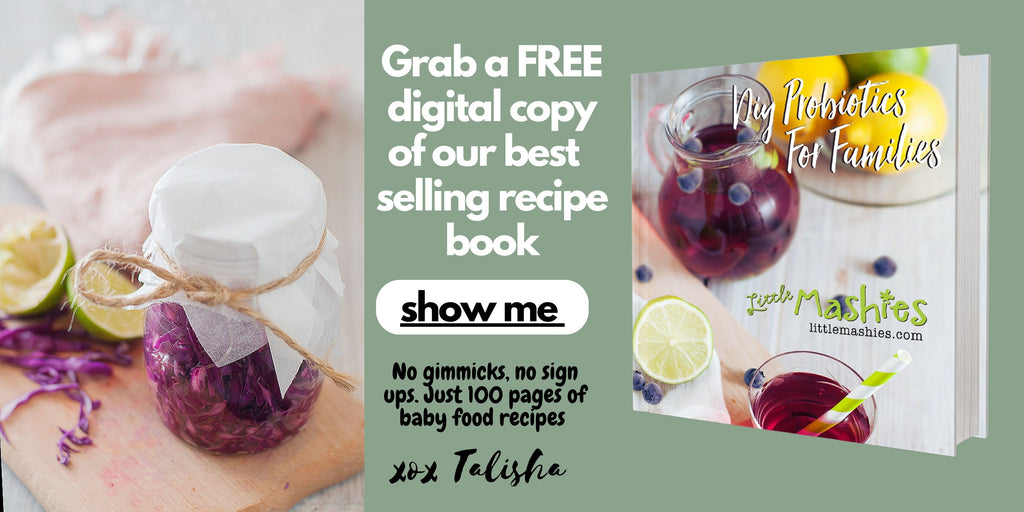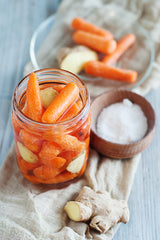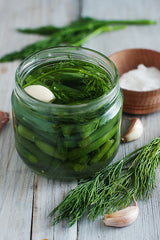Basic Sauerkraut
Basic Sauerkraut
Ingredients:
1 organic cabbage, outer leaves removed
1-3 Tbsn celtic sea salt (about 20-30g to every 1kg of cabbage)
Optional:
1 cup filtered water + 1 tspn salt for extra brine
3 Tbsn Lemon/ Lime juice
Method
Step 1:
Remove outer leaves and impurities from organic purple cabbage. Reserve the outer leaves for later.
Step 2:
Cut the cabbage in half and remove the core. Reserve this for later use, then cut the cabbage again so it is in quarters.
Step 3:
Slice your cabbage. The width can be anywhere from 5mm to 20mm wide. The wider the slices, the crunchier the kraut will be. A good place to start is 0.5-1cm wide.
Step 4:
Place sliced cabbage into a large bowl a handful at a time, covering each handful with a dash of salt until all the cabbage is in the bowl. Taste the cabbage as you salt to see if you like the level of saltiness. Add a little more of less depending on your taste buds. 20g per 1kg of cabbage is a good starting point but I love it at about 30g per kilo as it's a little bit more sour. When you taste the raw salted cabbage I think it should taste salty like the way you would like your hot chips salted. That's how I judge it when I haven't measured the cabbage weight.
Step 5:
Massage the cabbage with your hands by opening & closing your fist while the cabbage is inside the palm of your hand. This, with the salt, pops the walls of the cells in the cabbage, releasing water. When the cabbage is moist it is ready to be jarred.
Step 6:
Mix in the lime juice or leave as is.
Step 7:
In a large glass jar, place a small handful of the cabbage mix, pushing it down so that it is very firm and compact. You will need to use quite a bit of pressure. Continue in this fashion until the last of your cabbage mix is firmly squashed into the jar. There should be around about a 1-2 inch gap between the top of the cabbage and the lid of the jar. By this stage salty water should have risen to the top of the cabbage mix. If it has not risen use the filtered water and additional salt to create brine. For every 250mls of water you add, you should add a teaspoon of salt. Most likely though you will only be topping the mixture up slightly so a pinch of salt in a dash of water would be enough.
Step 8:
Fold the outer cabbage leaves in the shape of the lid of the jar. Push this down on top of the kraut mix like a plug, ensuring all parts of the leaves are submerged under liquid. This is so the mixture does not come into contact with air.
Step 9:
If there is still a fair amount of room between the top of your cabbage and the lid of the jar you can use a large piece of the cabbage core to push down the cabbage mix further and place the lid on. When the beneficial bacteria begin to multiply they give off gas and bubbles and the mixture pushes up with the pressure. You want to ensure the cabbage mixture is fully submerged all of the time, hence why you go to great lengths to push it down.
Step 10:
Place a plate under the jar and keep it in a cupboard. Juices are likely to seep out of the top and onto the plate. Check the kraut regularly (every day) and push it down as needed so it is always under the brine. You can also add more salty water if needed but usually this isn’t necessary.
Step 11:
Transfer to the refrigerator when you are happy with the level of acidity within the mixture (1-12wks). The only way to know what you like is to taste your mix every few days, making sure you push everything back down under the brine and only use clean utensils! Most people just starting out with ferments prefer a less acidic taste, thus a shorter fermenting time is used to achieve this. 2 weeks is a great starting point.

Other Fermented vegetable recipes to try











